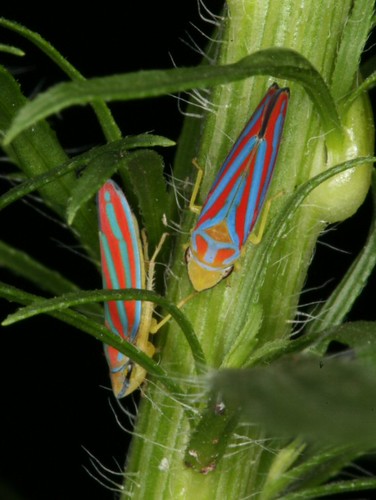tags: Rhododendron Leafhopper, Graphocephala fennahi, Image of the Day
I noticed you have been featuring insect images regularly on the blog. [This is] a pic of a Rhododendron Leafhopper, Graphocephala fennahi, that I took yesterday. These are quite common (but small, about 1/4 inch in length) cicadellids in North America, but have also colonized the UK and continental Europe after they were introduced (accidentally) in the UK about 70 years ago.
Image: David A. Rintoul, KSU [larger]
More about this species below the fold ..
Leafhoppers and their relatives, the cicadas, are insects that have long needle-shaped mouthparts. They often have two pairs of membranous wings, which are usually folded over the body in the shape of a roof. Their antennae are very short. Not only are most cicadas good flyers, many are excellent jumpers as well.
The adults lay their eggs in the unopened flower buds of rhododendrons in late summer and autumn. Often these eggs provide a point of entry for a fungal disease known as Rhododendron bud and twig blight, which kills the buds before they open. The eggs hatch the following April and the young nymphs, like the adults, feed on sap from the undersides of the leaves. The nymphs are difficult to see because they are nearly transparent.
These colorful insects are especially noticeable in the early morning when they sit in the sunlight to warm up their bodies. As you approach them they often jump away to safety. They make a "clicking" noise when they kick their long back legs against the leaves and launch themselves into the air. The adults have wings to help them move around, but they only fly distances of between one and three meters.
Currently, there are many taxonomic revisions occurring in this group of insects.


At last, something I have seen often!
Do the leafhoppers benefit from the fungus infection? Do they hatch better in dead buds than in open flowers?
Keep up with the insects!
carl; i don't think that the fungus has any effect on the leafhoppers. i think it is an accidental by-product of them making a hole in the plant's integument.
(but i will remind you that i am not a professional entomologist, even though i have taken a few classes and worked with (and kept) insects during part of my graduate career).